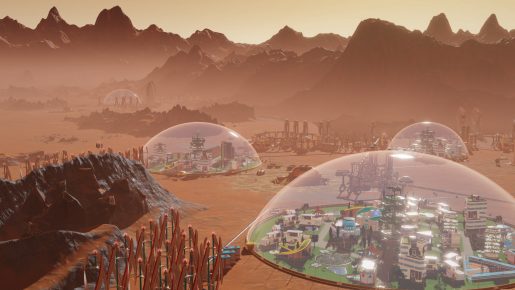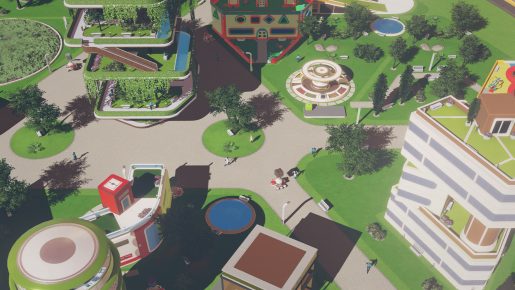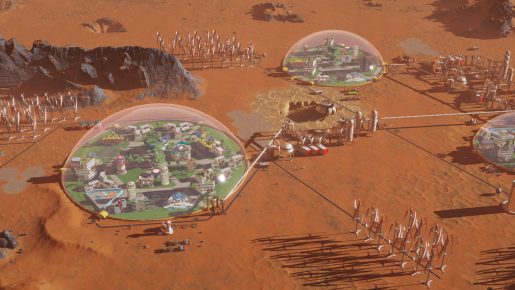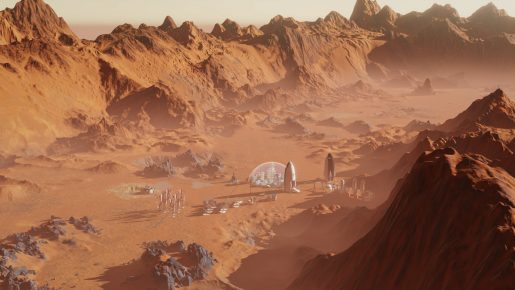Surviving Mars is the latest game from Haemimont Games, otherwise known for making the Tropico series of city-building games. Surviving Mars is also a city-builder of sorts, focusing as the name suggests on setting up a colony on the red planet.
To start with, you’re going to be shepherding drones around to create the infrastructure needed to support the human colonists who will come along later. Drones are attached to hubs and can only perform tasks within a range around that hub; they cannot use the control range of other hubs to determine what tasks to perform. Early on the fact that the drones are limited only to their range of their own hub makes little difference, but later this results in some juggling of resources between different zones of control. These resources take the form of raw or processed materials like metals or concrete, echoing other colony builder games like Rimworld. You do also have a supply of money which is used to purchase supplies from Earth, but you’re also going to need to have a rocket available to ferry those supplies.

Before you can get drones going though you need to choose your sponsor and landing location, which is effectively how you set the difficulty of a given game. This is a pretty critical decision as the difficulty range is very large, with low settings making the game a relaxing city builder while harder settings bring the ‘surviving’ part of the title to the forefront of the gameplay. You can also choose from a number of different mysteries, which are long quest/story chains which you will uncover throughout the game; there are nine to choose from or you can have one selected at random. Again, the mysteries have different associated difficulties so this is yet another dial to play with to customize your experience.
Once you have got the basic life support equipment built including the first habitation dome the first rocket-load of colonists can be sent to Mars. Colonists are drawn from a pool of applicants who all have different traits and abilities, some good and some bad. While this adds some interest I did find it a little jarring that people being considered for Mars colonization included alcoholics and those with gambling addictions, at least with a sponsor like the International Mars Mission. New traits and also be developed by your colonists once on Mars, which would potentially be interesting but actually exploiting positive traits effectively is a fiddly task and doesn’t provide enough of a benefit to feel worth the effort.

Both before and after you’ve got colonists in your domes, one of the biggest tasks that your drones will be performing is the continual maintenance of structures. Everything suffers damage over time through use, but can also be damaged by weather and meteorite strikes. The famous red dust that defines the appearance of Mars also causes problems, gradually coating buildings over time. This is a great effect and really adds a sense that the colony is blending in with the landscape, which is a great contrast with the very bright aesthetic most of the structures have.
Having colonists on Mars opens up a huge range of buildings which require human crew. The majority of these are built within the limited slots of the habitation domes, like the research lab or a grocery store. A grocery store may not sound like it should be a high priority for a new mars colony but this is just one of measures you can take to improve and maintain morale, which is important to ensure that your colonists are happy enough to start making babies and expand your workforce.
Critical resources like metals are only attainable in the long term from mines which need a human workforce, replacing the rapidly diminishing surface resources accessible by drones which fuel the initial expansion. This need to switch to human-produced resources drives colony expansion, as does the need to stop relying on resources sent from Earth which consume your money. True self-sufficiency is a lofty goal though, so there are also rare resources which you can gather to send back on the supply or passenger rockets which brought you to Mars, once they’ve been refueled of course.

To help with containing that workforce you can research progressively larger habitation domes which allow you to construct more interesting mixes of buildings rather than simply focusing on the basic requirements of habitation and reproduction as you are all but forced to do in the beginning. There are lots of moving parts to keep an eye on which keeps the game feeling a lot more hands-on than many city-builders, particularly on higher settings.
This hands-on feel of the game seems to be somewhat by design but is also the product of a somewhat shaky user interface. Many of the menus are messy and provide only a broad overview – getting detailed information takes far too much work and becomes a bit of a chore once your colony has grown to the fairly impressive scales they can get to. It is still possible to keep everything under control but this adds stress to what is already a more stressful game than most in the genre.

In terms of performance the game ran well with no obnoxious load times despite being installed on a conventional hard drive, and a range of graphics settings should allow most PCs to handle it though as ever it is worth checking your hardware against the requirements. For those with high resolution screens UI scaling is present so everything is nice and readable at least up to a 4k screen.
Verdict
All in all Surviving Mars is a good game held back by some clumsiness in presentation, but is one of very few games which has combined survival with city building, and in a unique but relatable setting. The fact that you can tailor the difficulty so wildly means it should appeal to a broad range of players, and the variety of mysteries to uncover in each playthrough should mean there’s a decent amount of replayability. This is particularly important as there is only sandbox play available, there is no story-based campaign of missions like you’d find in Tropico, but that’s not too unusual in this genre so isn’t really a problem. If you like city builders and/or survival games this is definitely worth taking a look at.
